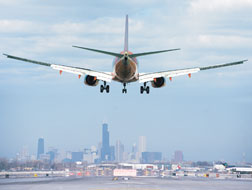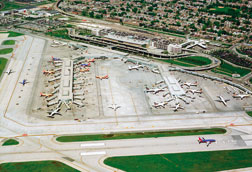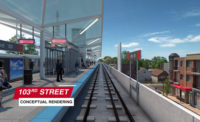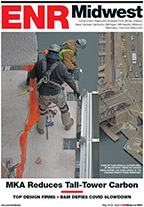  Photos courtesy of the Chicago Dept of Aviation Midway handled 304,000 flights in 2007. |
Construction could benefit if a $2.521-billion deal announced Sept. 30 by Chicago officials to privatize Midway International Airport is approved.
The city could net a fair amount of money targeted for future infrastructure projects as part of the 99-year agreement. About $1.5 billion would be used to retire airport debt, says Lisa Schrader, deputy CFO in the Chicago Dept of Finance. That would leave slightly more than $1 billion.
Illinois law requires 90% of the proceeds to be used for infrastructure improvements, she says. As a result, up to $900 million could be used for future construction, although half that could be diverted to a pension fund if the city sees fit. The remaining $100 million can be used as the city wishes.
“We’re very pleased with the deal, particularly during the current credit crisis in the markets,” Schrader says.
Chicago’s City Council must approve the deal.
The winning bid was from an organization called Midway Investment and Development Co. LLC. New York-based Citi Infrastructure Investors is the dominant partner because it would pony up 89% of the cash, Schrader says. The others comprise Boston-based John Hancock Life Insurance Co. (7%) and Vancouver, British Columbia, Canada-based YVR Airport Services Ltd. (4%).
“That’s how these transactions work: You have equity partners, and you have an operator [YVR],” she says. YVR owns and operates 18 airports on three continents. Half of YVR is owned by the Vancouver Airport Authority, and the other half is held by Citi.
The deal is for less money than some observers expected and at the upper end in timeframe than Chicago itself anticipated.
After the city announced in April that it had received responses to its request-for-qualifications, transportation experts projected that the deal could draw bids as high as $3.5 billion [ENR digital edition, May 21]. The city itself announced in a release issued April 1 that the agreement “is anticipated to be at least 50 years.”
But the deal might have been affected by financial turmoil from a collapsing credit market, turbulence on Wall Street and wheezing economy nationwide.
“These deals are a harder bargain than they were a year or two ago,” says Joseph Schwieterman, transportation professor in the Dept of Public Service Management and director of the Chaddick Institute for Metropolitan Development at DePaul University. “The airline situation is so dire that you cannot ignore the risks of another round of bankruptcies cutting into the revenue stream.”
Neither the number of bids nor their amount can be released until the transaction has closed, Schrader says. In April, the city said that it had received qualification statements from six teams.
The outlook for Midway users is mixed if the deal is OK’d.
On the upside, rates and charges assessed to airlines, which are typically passed off to users, would be frozen for six years, Schrader says. But other fees could increase, including for parking, concessions and ancillary services. For instance, she says that one-eighth of Midway’s 1,400 parking spots could remain capped at current rates.
“They [MIDCo] could institute a more strategic pricing method than we use,” she says.
“We expect FAA approval by the end of the year, and we wouldn’t close until the first quarter [of 2009],” Schrader says. In 2007, Midway handled nearly 304,000 flights and 19 million passengers.
Midway could be the first major airport to be leased nationwide and the second overall to try the experiment, DePaul’s Schwieterman says. Stewart International Airport, which is 55 mi north of New York City, was leased to a British firm in 2000, but the Port Authority of New York and New Jersey assumed the contract in 2007 in part because the operator encountered local opposition when it was not willing to expand the terminal and parking.
In 1996 the FAA announced that it would allow five airports to be leased. Schwieterman says likely next targets are “big, mature airports where land area is fairly fixed.” He cites New York’s Laguardia, a Bay Area airport and—more remotely—Reagan National Airport in Washington, D.C.



Post a comment to this article
Report Abusive Comment